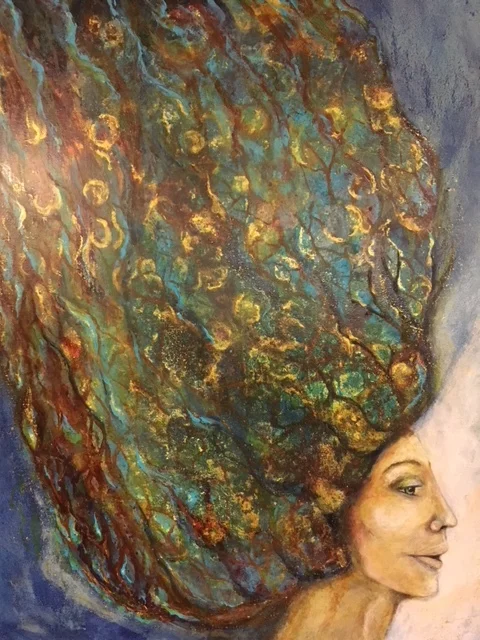By Sibel Ozer
“Season’s Changes,” the process-painting group I've been offering through The Women’s Center of Southeastern Michigan, is going strong. As we increase our awareness of the context of our lives, we simultaneously attend to the changes inside of us. We stay with the same canvas for four weeks in a row and paint away without an attachment to creating “masterpieces” (or thoughts of, Is it good enough? Pretty enough? Intact enough? etc.).
Painting in this way is a mindfulness practice more than anything else. Instead of sitting, we paint; instead of coming back to the breath, we come back to what our hands want to do from moment to moment. The nature of the mind doesn't change with the activity itself; we still get hijacked by thoughts of the past or future, or are influenced by critical inner voices, such as, It’s supposed to look like something by now, or What everyone else is doing is so much cooler, or I can’t really change it in the last week …
So we practice giving permission to the deeper needs of the psyche over the loud and domineering voices of our inner critic. In the end it is empowering and inspiring to practice within the safety of materials and community, where our choices don’t have serious life consequences.
“So we practice giving permission to the deeper needs of the psyche over the loud and domineering voices of our inner critic. ”
I participate in order to model engagement with freedom. I am caught off guard when I find that the process actually benefits me even in my primarily facilitator role.
Let me backtrack a little and tell you what’s been on my plate.
I’d been getting ready to move into a larger and more art therapy friendly office for a while. The decision that it was time was half the hurdle. Next, came the search for the right place. This part turned out to be way longer and tedious than expected. I came across two dream places, as well as a whole bunch of more reasonable, decent enough alternatives. There were some outside factors too, which looking back, could be interpreted as mere luck, or the universe looking out for me. I found myself going back and forth between wanting to go for a dream (attitude of trust) or be responsible and reasonable (attitude of scarcity fueled by doubts and fears).
At the same time, in the art group, I was inviting going for what felt right, as opposed to giving in to our internal “shoulds.”
During the second week of the third art group I realized my previously layered and colorful canvas wanted to be covered in black.
Probably five minutes into this process my inner critic whispered, Look at all these pretty colors showing through the layers, you really should keep them, and Maybe you should consider how your choice is impacting group members; what if they think you are depressed, going all black, and begin to worry about you, or worse, the safety of the group, or even worse, your capacity to facilitate? ...
I shared my process with the group members as they shared their own engagement along the should/want continuum. The good news is that once you give permission to what wants to happen, a great sense of fulfillment follows.
It occurred to me that everything is birthed out of the dark; that it is out of the void that things begin to emerge. With that rephrase I was able to stay with the black as long as I needed.
What first appeared out of the void was a snake, an ancient symbol of transformation. The week after that, the face of Kuan Yin began to take form. She is the embodiment of compassion, an archetype of the therapist role. I experienced her image to be offering validation for my wants.
“During the second week of the third art group I realized my previously layered and colorful canvas wanted to be covered in black.”
So by the time the group came to an end, I had complete permission to go for the space that I most wanted instead of the possible other options that would have been less risky.
I have to mention that my husband’s support was essential.
I am not suggesting that the art process solely influenced this important decision, but it helped me not to lose sight of my deepest dream. I am now operating out of an amazing downtown basement space and couldn't be happier.
It is not easy to think big or to follow our heart’s deepest desires in the face of everyday realities and logical reasons against it. It is less a problem of being practical and logical, both of which are much needed ego functions. It is more about finding the right balance between them. Making sure we are listening to the voices of support, permission, and deservedness as much as the logical arguments.
When last did you listen to your heart’s deepest desires?
Even as you practice gratitude, do you believe you deserve more? better?
Sibel Ozer is a licensed professional counselor and board-certified art therapist. You can contact Sibel at he-artspace@hotmail.com.








































































































































































































While environmental scientists across the world were working hard to finalize the assessment of the 2019 UN Report on the State of the Environment, I was eagerly descending the steps to my basement art therapy office on Main Street, Ann Arbor so I could put the finishing touches on my latest painting. I’ve felt this space to be particularly compatible with psychological work that requires a quieting of the mind chatter in order to be able to access inner wisdom.